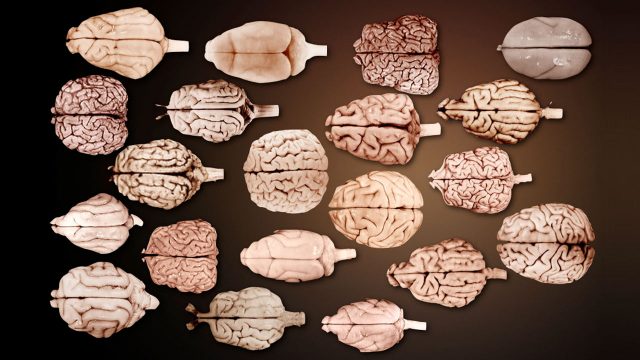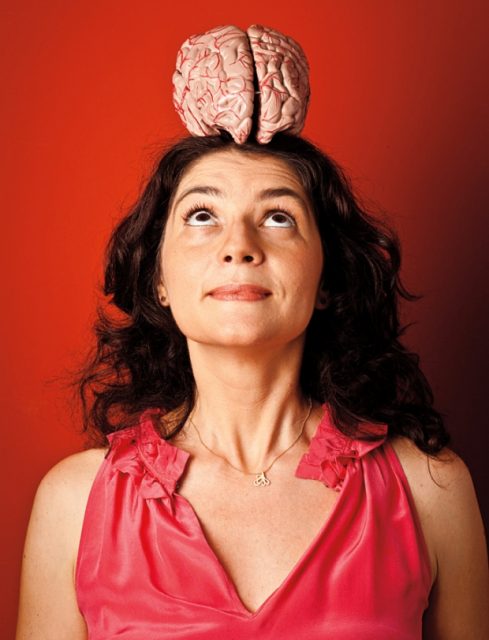Folded brains

There are two main groups of mammalian brains. Lissencephalic brains have a smooth surface and can be found, for example, in mice, rats or manatees. Gyrencephalic brains, by contrast, have deeply folded brains with gyri (ridges) and sulci (depressions or furrows). They are found, for example, in cats, dogs, pigs, whales, elephants and primates including humans. In addition, brain size varies by over 100,000 times, just across mammals. As a general rule, larger brains tend to have more folded cortices, but what makes the cortex fold has remained under discussion.
The disposition of gyri and sulci seems to be highly ordered. Notable gyri can be distinguished in all individuals from the same species and have been widely used as anatomical landmarks. Thus, one would think that brain surface construction is a perfectly regulated process where specific instructions govern how brains are built step by step.
A recent study published in Science 1 shows that this is not the case and the folding of cortical surface follows in all species a simple mathematical relationship, called a scaling law. It is a good example of evolution at work since the varied forms of brains in different species do not arise from specific developmental patterns carefully regulated in each taxon but rather from the same physical process and cramming a brain into a skull may be as easy as just wadding it up 2. The reason for the folding in the gyrencephalic brains is remarkably simple: it minimizes their effective free energy. Brains take the most stable configuration in the skull cavity.
It is generally accepted that the reason for folding is to increase the total area of the cerebral cortex. This is a highly significant structure and if the aim is to localize more functions, more area is needed, and if available volume is constricted by the skull measures, the only solution is to fold the cortex.
For the past 10 years, Suzana Herculano-Houzel and Bruno Mota, neuroscientist and physicist respectively, from the Universidade Federal do Rio de Janeiro have been measuring the brains of 62 mammals, including marsupials, primates and dolphins. They recorded each brain’s volume, surface area and thickness of the cerebral cortex, as well as the degree to which they were folded. They also counted the number of cortical neurons.
Previous theories considered that the number of neurons would drive the folding process: add more neurons and the brain will need more convolutions to have enough space to build their circuitries and connect them with presynaptic and postsynaptic neurons. But this idea does not fit with available data. Elephants, for example, have twice as many folds in their huge brains as humans do, but only about one-third the number of neurons.
The reasoning of Herculano-Houzel and Mota was straightforward. First, there is the surface of the cortex: the larger it is, the more gyri and sulci a brain is likely to have. The second factor is the thickness of the cortex; the thicker it is, the number of possible folds is limited. Working with these two numbers, it can be figured out how a given animal’s brain should look.
The Brazilian team plotted the area of cortex times the square root of its thickness versus of the exposed area of the brain. Surprisingly, all data points, including from both lissencephalic and gyrencephalic brains, fell on a single universal curve. Thus, unless new evidence are found proving otherwise, the two researchers can be credited with finally coming up with an equation to describe why mammalian brains look the way they do when compared to one another.

This model also explains the scaling of the folding index of crumpled paper balls, something that the authors checked balling up sheets of standard-sized A4 office paper. They made stacks of 1, 2, 3, 4, 6 or 8 sheets of paper and they demonstrated how the increasing thickness of the surface subjected to pressures results in progressively less highly folded paper balls.
Occasionally, humans can suffer a developmental defect in the neural migration during the 12th to 24th weeks of gestation resulting in the lack of brain folds, a disorder called lissencephaly. Affected children display severe psychomotor retardation, seizures, muscle problems and their life expectancy is usually severely shortened, generally due to respiratory malfunction. The present study also provides some insights in human lissencephaly.

Suzana Herculano-Houzel is a good example of the contrasting situation of science in Latin America. She is a famous science popularizer with a program in television, has sold more than 60,000 copies of her books and the research of her team is in a good moment as it is exemplified by this recent Science paper. On the other hand, she is on the risk of having to close her lab for lacking funds. As O Globohas published, the National Counsel for Scientific and Technological Development had approved a grant for 50,000 USD, enough for keeping the lab running for three years, but only a fraction of this money has reached the researchers. Two other projects by the Foundation for Research of Rio de Janeiro have been approved, but there are no indications when the money will be available. Finally, a big grant from the James McDonnell Foundation, an American institution, for 600,000 USD requires a huge bureaucratic work to use the funds, and they can be blocked due to the financial crisis in the Brazilian institution. Herculano-Houzed has declared to the press that is seriously considering leaving the country. Her web page is recommended.
References
- Herculano-Houzel S, Mota B (2015) Cortical folding scales universally with surface area and thickness, not number of neurons. Science 349(6243): 74-77. DOI: 10.1126/science.aaa9101 ↩
- Cho A (2015) Your brain is like a wad of paper. Science DOI: 10.1126/science.aac8797 ↩
1 comment
[…] Todos sabemos que el encéfalo humano presenta muchos pliegues, pero, ¿qué es lo que hace se pliegue? Porque no todos los animales tienen pliegues. Nos lo cuenta José Ramón Alonso en Folded Brains. […]